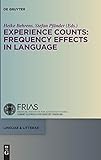Experience Counts: Frequency Effects in Language / ed. by Heike Behrens, Stefan Pfänder.
Material type: TextSeries: linguae & litterae : Publications of the School of Language and Literature Freiburg Institute for Advanced Studies ; 54Publisher: Berlin ; Boston : De Gruyter, [2016]Copyright date: ©2016Description: 1 online resource (VIII, 254 p.)Content type:
TextSeries: linguae & litterae : Publications of the School of Language and Literature Freiburg Institute for Advanced Studies ; 54Publisher: Berlin ; Boston : De Gruyter, [2016]Copyright date: ©2016Description: 1 online resource (VIII, 254 p.)Content type: - 9783110343427
- 9783110384598
- 9783110346916
- Frequency (Linguistics)
- Language acquisition
- Language and languages -- Variation
- Linguistic change -- Variation
- Linguistic change
- Psycholinguistics
- Fremdsprachenerwerb
- Sprachwandel
- LANGUAGE ARTS & DISCIPLINES / Linguistics / General
- Language Change
- Second Language Acquisition
- Usage-based Linguistics
- 410 23
- P128.F73 E96 2016
- online - DeGruyter
- Issued also in print.
| Item type | Current library | Call number | URL | Status | Notes | Barcode | |
|---|---|---|---|---|---|---|---|
 eBook
eBook
|
Biblioteca "Angelicum" Pont. Univ. S.Tommaso d'Aquino Nuvola online | online - DeGruyter (Browse shelf(Opens below)) | Online access | Not for loan (Accesso limitato) | Accesso per gli utenti autorizzati / Access for authorized users | (dgr)9783110346916 |
Browsing Biblioteca "Angelicum" Pont. Univ. S.Tommaso d'Aquino shelves, Shelving location: Nuvola online Close shelf browser (Hides shelf browser)

|

|

|

|

|

|

|
||
| online - DeGruyter Variation in Language: System- and Usage-based Approaches / | online - DeGruyter Code-switching Between Structural and Sociolinguistic Perspectives / | online - DeGruyter Die amerikanischen Götter : Transatlantische Prozesse in der deutschsprachigen Literatur und Popkultur seit 1945 / | online - DeGruyter Experience Counts: Frequency Effects in Language / | online - DeGruyter Plots, Designs, and Schemes : American Conspiracy Theories from the Puritans to the Present / | online - DeGruyter Literarische Deutschlandreisen nach 1989 / | online - DeGruyter New Trends in Nordic and General Linguistics / |
Frontmatter -- Contents -- Acknowledgements -- Experience counts: An introduction to frequency effects in language -- Explaining variation in plural marking of German noun insertions in Russian sentences -- Hesitation placement as evidence for chunking -- Recency as a factor of phonological variation -- Frequency effects in lexical sociolectometry are insubstantial -- Input optimization -- Modeling frequency effects in language change -- Frequency and lexical specificity in grammar: A critical review -- Frequency in language learning and language change
restricted access online access with authorization star
http://purl.org/coar/access_right/c_16ec
Frequency has been identified as one of the most influential factors in language processing, and plays a major role in usage-based models of language learning and language change. The research presented in this volume challenges established models of linguistic representation. Instead of learning and processing language compositionally, larger units and co-occurence relations are at work. The main point taken by the authors is that by studying the effect of distributional patterns and changes in such patterns we can establish a unified framework that explains the dynamics of language systems with a limited set of processing factors.
Issued also in print.
Mode of access: Internet via World Wide Web.
In English.
Description based on online resource; title from PDF title page (publisher's Web site, viewed 25. Jun 2024)


